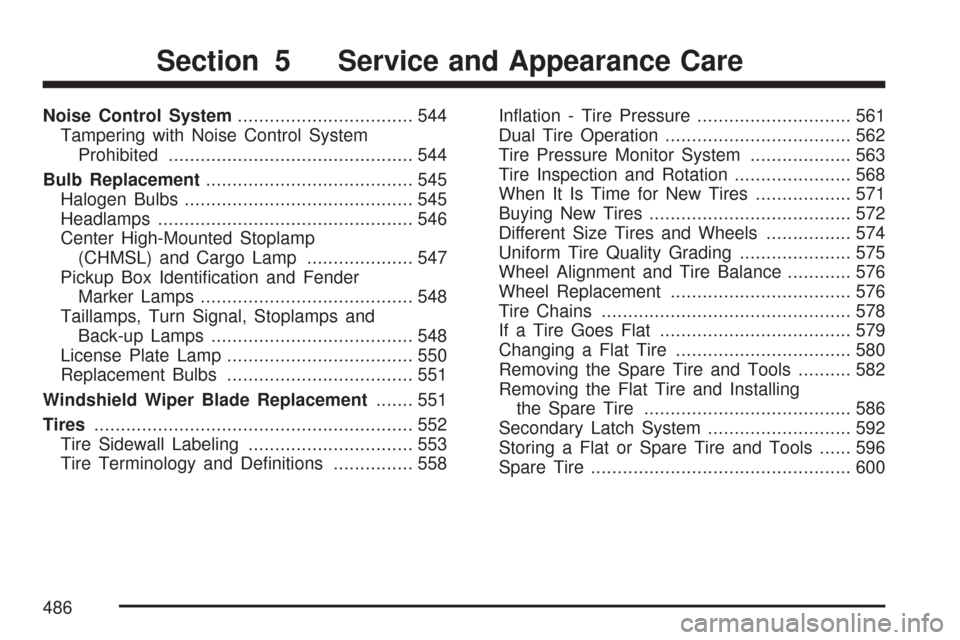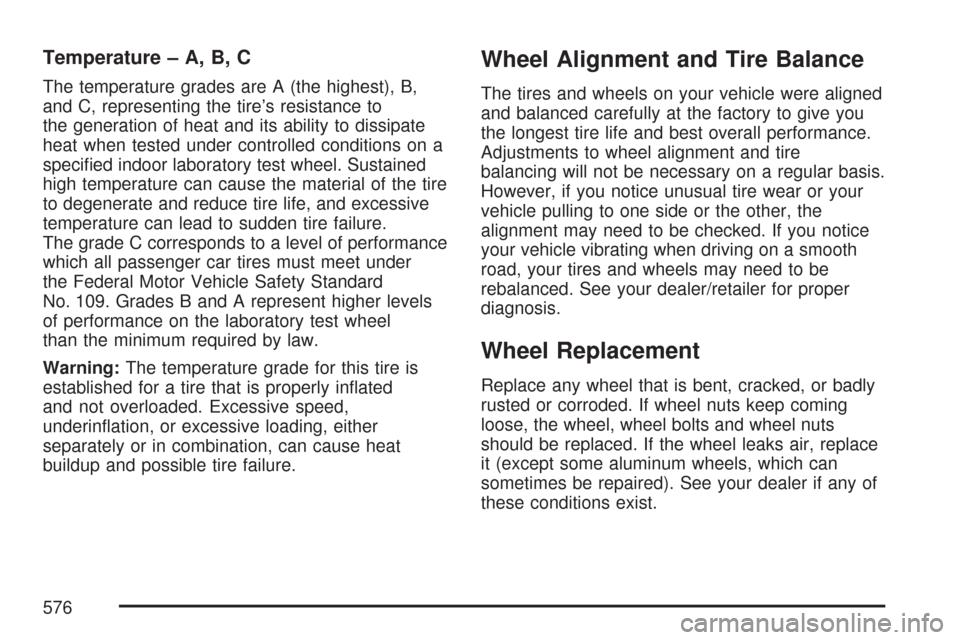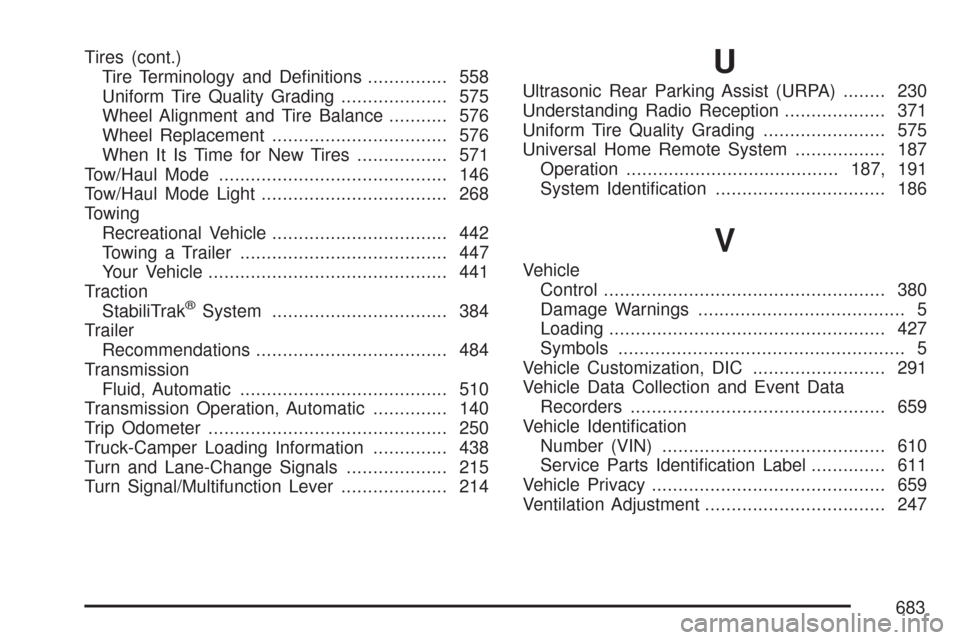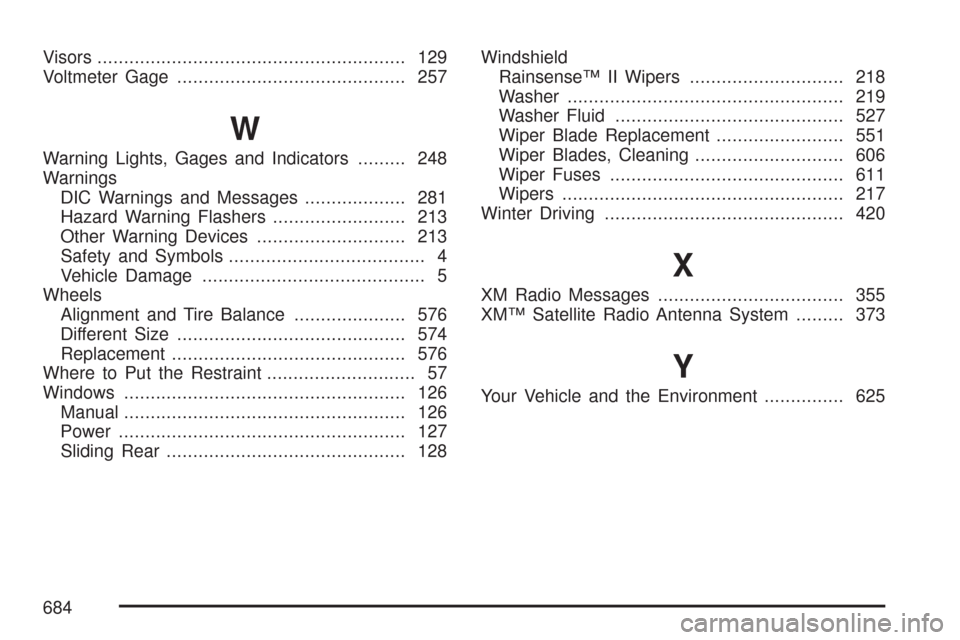2007 CHEVROLET SILVERADO wheel alignment
[x] Cancel search: wheel alignmentPage 486 of 684

Noise Control System................................. 544
Tampering with Noise Control System
Prohibited.............................................. 544
Bulb Replacement....................................... 545
Halogen Bulbs........................................... 545
Headlamps................................................ 546
Center High-Mounted Stoplamp
(CHMSL) and Cargo Lamp.................... 547
Pickup Box Identi�cation and Fender
Marker Lamps........................................ 548
Taillamps, Turn Signal, Stoplamps and
Back-up Lamps...................................... 548
License Plate Lamp................................... 550
Replacement Bulbs................................... 551
Windshield Wiper Blade Replacement....... 551
Tires............................................................ 552
Tire Sidewall Labeling............................... 553
Tire Terminology and De�nitions............... 558In�ation - Tire Pressure............................. 561
Dual Tire Operation................................... 562
Tire Pressure Monitor System................... 563
Tire Inspection and Rotation...................... 568
When It Is Time for New Tires.................. 571
Buying New Tires...................................... 572
Different Size Tires and Wheels................ 574
Uniform Tire Quality Grading..................... 575
Wheel Alignment and Tire Balance............ 576
Wheel Replacement.................................. 576
Tire Chains............................................... 578
If a Tire Goes Flat.................................... 579
Changing a Flat Tire................................. 580
Removing the Spare Tire and Tools.......... 582
Removing the Flat Tire and Installing
the Spare Tire....................................... 586
Secondary Latch System........................... 592
Storing a Flat or Spare Tire and Tools...... 596
Spare Tire................................................. 600
Section 5 Service and Appearance Care
486
Page 568 of 684

Federal Communications Commission
(FCC) and Industry and Science
Canada
The Tire Pressure Monitor System (TPMS)
operates on a radio frequency and complies with
Part 15 of the FCC Rules. Operation is subject
to the following two conditions:
1. This device may not cause harmful
interference.
2. This device must accept any interference
received, including interference that may
cause undesired operation.
The Tire Pressure Monitor System (TPMS)
operates on a radio frequency and complies with
RSS-210 of Industry and Science Canada.
Operation is subject to the following two
conditions:
1. This device may not cause interference.
2. This device must accept any interference
received, including interference that may
cause undesired operation of the device.
Changes or modi�cations to this system by other
than an authorized service facility could void
authorization to use this equipment.
Tire Inspection and Rotation
Tires should be rotated every 5,000 to 8,000 miles
(8 000 to 13 000 km).
Any time you notice unusual wear, rotate your
tires as soon as possible and check wheel
alignment. Also check for damaged tires or wheels.
SeeWhen It Is Time for New Tires on page 571
andWheel Replacement on page 576for
more information.
Make sure the spare tire is stored securely. Push,
pull, and then try to rotate or turn the tire. If it
moves, use the wheel wrench/hoist shaft to tighten
the cable. SeeChanging a Flat Tire on page 580.
If your vehicle has dual rear wheels, also see
Dual Tire Operation on page 562.
The purpose of regular rotation is to achieve more
uniform wear for all tires on the vehicle. The
�rst rotation is the most important. SeeScheduled
Maintenance (Gasoline Engine) on page 627.
568
Page 576 of 684

Temperature – A, B, C
The temperature grades are A (the highest), B,
and C, representing the tire’s resistance to
the generation of heat and its ability to dissipate
heat when tested under controlled conditions on a
speci�ed indoor laboratory test wheel. Sustained
high temperature can cause the material of the tire
to degenerate and reduce tire life, and excessive
temperature can lead to sudden tire failure.
The grade C corresponds to a level of performance
which all passenger car tires must meet under
the Federal Motor Vehicle Safety Standard
No. 109. Grades B and A represent higher levels
of performance on the laboratory test wheel
than the minimum required by law.
Warning:The temperature grade for this tire is
established for a tire that is properly in�ated
and not overloaded. Excessive speed,
underin�ation, or excessive loading, either
separately or in combination, can cause heat
buildup and possible tire failure.
Wheel Alignment and Tire Balance
The tires and wheels on your vehicle were aligned
and balanced carefully at the factory to give you
the longest tire life and best overall performance.
Adjustments to wheel alignment and tire
balancing will not be necessary on a regular basis.
However, if you notice unusual tire wear or your
vehicle pulling to one side or the other, the
alignment may need to be checked. If you notice
your vehicle vibrating when driving on a smooth
road, your tires and wheels may need to be
rebalanced. See your dealer/retailer for proper
diagnosis.
Wheel Replacement
Replace any wheel that is bent, cracked, or badly
rusted or corroded. If wheel nuts keep coming
loose, the wheel, wheel bolts and wheel nuts
should be replaced. If the wheel leaks air, replace
it (except some aluminum wheels, which can
sometimes be repaired). See your dealer if any of
these conditions exist.
576
Page 683 of 684

Tires (cont.)
Tire Terminology and De�nitions............... 558
Uniform Tire Quality Grading.................... 575
Wheel Alignment and Tire Balance........... 576
Wheel Replacement................................. 576
When It Is Time for New Tires................. 571
Tow/Haul Mode........................................... 146
Tow/Haul Mode Light................................... 268
Towing
Recreational Vehicle................................. 442
Towing a Trailer....................................... 447
Your Vehicle............................................. 441
Traction
StabiliTrak
®System................................. 384
Trailer
Recommendations.................................... 484
Transmission
Fluid, Automatic....................................... 510
Transmission Operation, Automatic.............. 140
Trip Odometer............................................. 250
Truck-Camper Loading Information.............. 438
Turn and Lane-Change Signals................... 215
Turn Signal/Multifunction Lever.................... 214
U
Ultrasonic Rear Parking Assist (URPA)........ 230
Understanding Radio Reception................... 371
Uniform Tire Quality Grading....................... 575
Universal Home Remote System................. 187
Operation........................................187, 191
System Identi�cation................................ 186
V
Vehicle
Control..................................................... 380
Damage Warnings....................................... 5
Loading.................................................... 427
Symbols...................................................... 5
Vehicle Customization, DIC......................... 291
Vehicle Data Collection and Event Data
Recorders................................................ 659
Vehicle Identi�cation
Number (VIN).......................................... 610
Service Parts Identi�cation Label.............. 611
Vehicle Privacy............................................ 659
Ventilation Adjustment.................................. 247
683
Page 684 of 684

Visors.......................................................... 129
Voltmeter Gage........................................... 257
W
Warning Lights, Gages and Indicators......... 248
Warnings
DIC Warnings and Messages................... 281
Hazard Warning Flashers......................... 213
Other Warning Devices............................ 213
Safety and Symbols..................................... 4
Vehicle Damage.......................................... 5
Wheels
Alignment and Tire Balance..................... 576
Different Size........................................... 574
Replacement............................................ 576
Where to Put the Restraint............................ 57
Windows..................................................... 126
Manual..................................................... 126
Power...................................................... 127
Sliding Rear............................................. 128Windshield
Rainsense™ II Wipers............................. 218
Washer.................................................... 219
Washer Fluid........................................... 527
Wiper Blade Replacement........................ 551
Wiper Blades, Cleaning............................ 606
Wiper Fuses............................................ 611
Wipers..................................................... 217
Winter Driving............................................. 420
X
XM Radio Messages................................... 355
XM™ Satellite Radio Antenna System......... 373
Y
Your Vehicle and the Environment............... 625
684